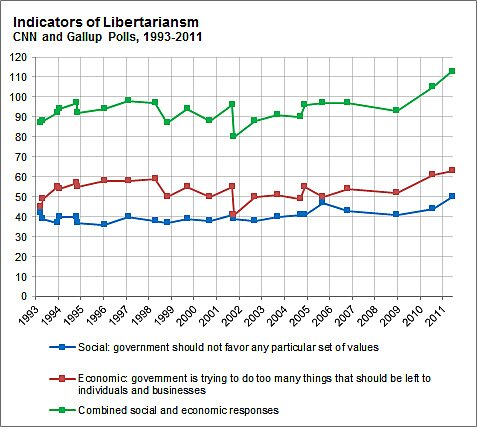Polling wizard Nate Silver of the New York Times today points to a couple of poll questions that David Kirby and I have often employed and finds some welcome new results, along with a great graph:
Since 1993, CNN has regularly asked a pair of questions that touch on libertarian views of the economy and society:
Some people think the government is trying to do too many things that should be left to individuals and businesses. Others think that government should do more to solve our country’s problems. Which comes closer to your own view?
Some people think the government should promote traditional values in our society. Others think the government should not favor any particular set of values. Which comes closer to your own view?A libertarian, someone who believes that the government is best when it governs least, would typically choose the first view in the first question and the second view in the second.
In the polls, the responses to both questions had been fairly steady for many years. The economic question has showed little long-term trend, although tolerance for governmental intervention rose following the terror attacks of Sept. 11, 2001. The social libertarian viewpoint — that government should not favor any particular set of values — has gained a couple of percentage points since the 1990s but not more than that.
But in CNN’s latest version of the poll, conducted earlier this month, the libertarian response to both questions reached all-time highs. Some 63 percent of respondents said government was doing too much — up from 61 percent in 2010 and 52 percent in 2008 — while 50 percent said government should not favor any particular set of values, up from 44 percent in 2010 and 41 percent in 2008. (It was the first time that answer won a plurality in CNN’s poll.)
And then he offers this graph:
Check out that green line! Kirby and I used those same two poll questions in our studies beginning with “The Libertarian Vote” (see p. 9). Like Gallup, we combined responses to the two questions in a matrix, finding in 2009 (in “The Libertarian Vote in the Age of Obama”) that 23 percent of the public held libertarian views. Adding them, as Silver has done, seems much more fun.

